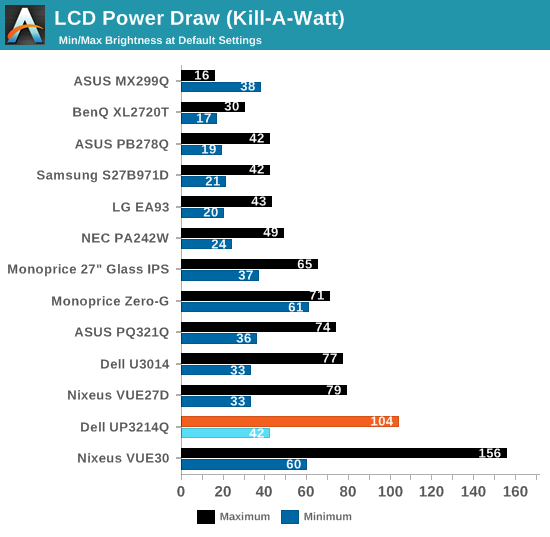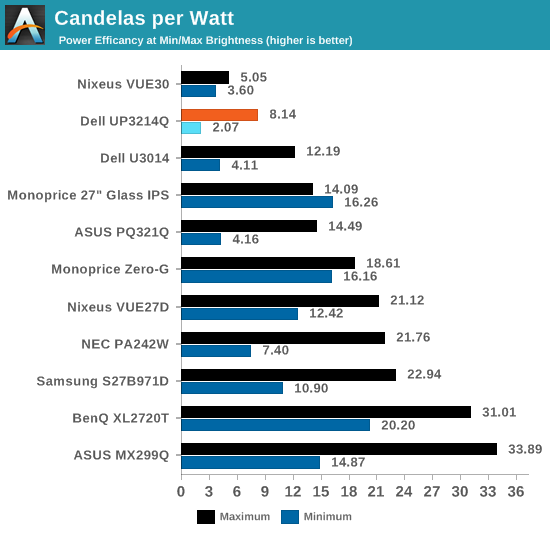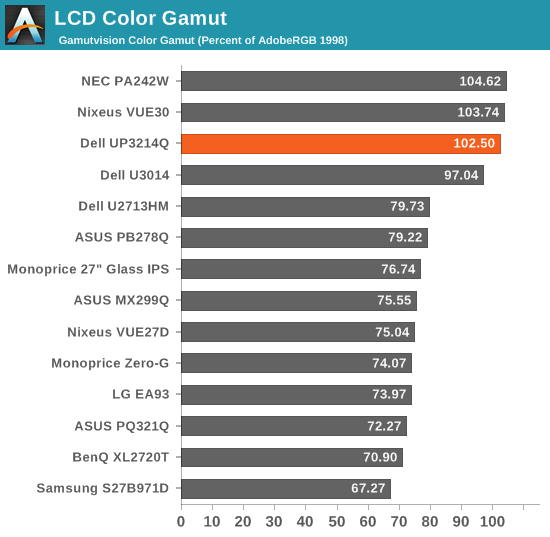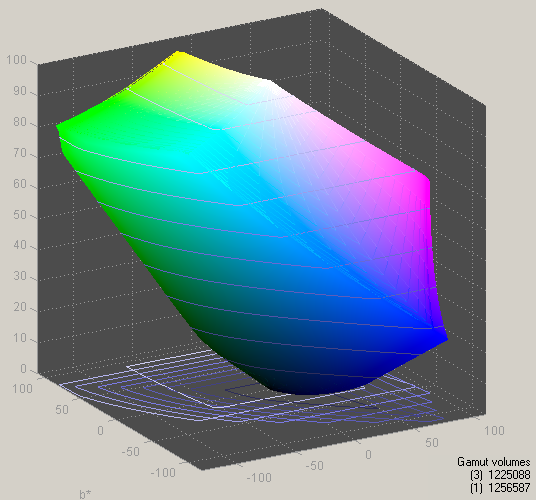Dell UP3214Q Review
by Chris Heinonen on April 1, 2014 12:00 AM ESTUsing the Leo Bodnar lag tester, I measure 47ms of lag on the UP3214Q using a 1080p signal. Without a game mode or anything else to speed up this processing, this is fairly slow. Most people probably won’t be playing many games at native UltraHD resolutions due to the graphics hardware required so measuring a non-native resolution signal, while never ideal, is probably closer to a real world situation here. For many people this will be too slow for gaming. This measurement is also done over HDMI, while almost everyone will use DisplayPort with this monitor to get 60 Hz, so that is another variable that might be different as well.

As a 32” display the UP3214Q is going to use power, and it consumes a decent amount. With the backlight at minimum is consumes 42 watts, and that climbs to 104 watts at maximum backlight. However this power use is still below the 30” Nixeus display that was recently reviewed, and even the 27” NEC PA271W professional display. The UP3214Q is less power efficient than either of those displays as they both have a higher maximum and minimum light output, even with the smaller screens.


The color gamut data has the same issue as the AdobeRGB data. A bug in the calibration has caused the gamut numbers to be off, so I’m reporting two different results. The one from my calibration is 82.7% of the AdobeRGB gamut. Using the included Dell ICC profile, it has 102.5% of the AdobeRGB gamut. Since the pre-calibration numbers appear to support the Dell ICC profile, I will say that the Dell UP3214Q supports the full AdobeRGB gamut as the specs say.












84 Comments
View All Comments
Kevin G - Tuesday, April 1, 2014 - link
On the Windows site of things, what video card and driver was used? How AMD and nVidia handle MST support varies slightly so you might have better luck with one over the other.Samus - Tuesday, April 1, 2014 - link
Wow, $2800 bucks...you can have a whole WALL of ZR2740w's for that price.nathanddrews - Tuesday, April 1, 2014 - link
... or a wall of U28D590D for $699 each. 60Hz TN 4K. I'm glad to see the major players offer up affordable 60Hz 4K. Of course, I'd rather have 120Hz 4K DP1.3. Doesn't matter if you can't play games, it would be of tremendous value to me just for desktop operations.Gunbuster - Tuesday, April 1, 2014 - link
Or you could run 4 39" 4K's at 1080p 120hz in multi-monitor and still have 4k resolution and some change left over...Bad pricing is bad.
WithoutWeakness - Tuesday, April 1, 2014 - link
If I'm correct in assuming you're talking about the 39" Seiko TV then I must inform you that those are not 120Hz screens in the same sense that a computer monitor is 120Hz. Those Seiko TV's only take an HDMI input which is currently limited to 4K@30Hz. They then interpolate frames between frames of source material to give the illusion of 120Hz. A 120Hz monitor takes in a 120Hz signal and displays it natively. There are currently no 4K 120Hz monitors on the market (there aren't even any 2560x1600 120Hz monitors I'm aware of).nathanddrews - Tuesday, April 1, 2014 - link
The 50" Seiki 4K TVs do native 120Hz 1080p over HDMI 1.4, but it seems to be a lottery as to whether it needs to be hacked or not. While this resolution is not officially supported, creating a custom EDID makes it possible. In addition, several people have been loading the 50" firmware on the 39", making native 120Hz 1080p possible there as well. So you can have your desktop and videos at 30Hz 4K (not ideal, but still razor sharp) while also gaming at 120Hz 1080p. Some are claiming 720p at native 240Hz... but I'd have to see that to believe it.http://www.avsforum.com/t/1473728/official-seiki-s...
houkouonchi - Friday, April 4, 2014 - link
All seiki 50 inch displays will natively display 1080p@120Hz. The 39 inch models all will to (with a firmware update). The 39 inch monitors with the firmware update do pixel doubling which means ideal scaling for gaming (almost identical to gaming on a big 1080p display with no scaling artifacts).Both the 50 inch (and 39 with the right firmware) will accept 720p@240Hz. It sitll only displays 120Hz but this does halve the input lag from around 9ms to 4.5 ms which is why for games where it really matters (only quakelive for me) I ran at 1280x720@240Hz.
marcosears - Thursday, October 9, 2014 - link
It's nice, but it could be a lot better! /Marco from http://www.consumertop.com/best-monitor-guide/dave_rosenthal - Tuesday, April 1, 2014 - link
Actually, the 39" inch Seiko *does* accept 1080@120hz over hdmi (when flashed with the firmware from 50" Seiko) and output all individual 120 frames per second (it looks very smooth!). You're right that it's limited to 4k@30hz.inighthawki - Tuesday, April 1, 2014 - link
Enjoy your massive bezel and spanning content across monitors.